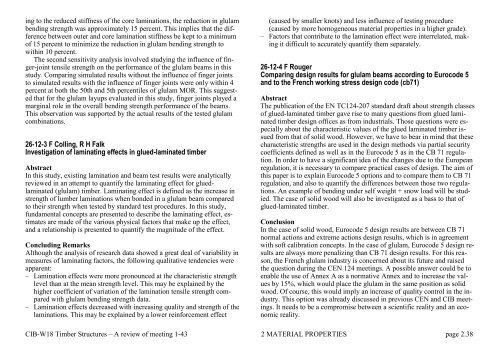CIB-W18 Timber Structures – A review of meeting 1-43 2 MATERIAL ...
CIB-W18 Timber Structures – A review of meeting 1-43 2 MATERIAL ...
CIB-W18 Timber Structures – A review of meeting 1-43 2 MATERIAL ...
- TAGS
- timber
- structures
- cib-w18.com
You also want an ePaper? Increase the reach of your titles
YUMPU automatically turns print PDFs into web optimized ePapers that Google loves.
ing to the reduced stiffness <strong>of</strong> the core laminations, the reduction in glulam<br />
bending strength was approximately 15 percent. This implies that the difference<br />
between outer and core lamination stiffness be kept to a minimum<br />
<strong>of</strong> 15 percent to minimize the reduction in glulam bending strength to<br />
within 10 percent.<br />
The second sensitivity analysis involved studying the influence <strong>of</strong> finger-joint<br />
tensile strength on the performance <strong>of</strong> the glulam beams in this<br />
study. Comparing simulated results without the influence <strong>of</strong> finger joints<br />
to simulated results with the influence <strong>of</strong> finger joints were only within 4<br />
percent at both the 50th and 5th percentiles <strong>of</strong> glulam MOR. This suggested<br />
that for the glulam layups evaluated in this study, finger joints played a<br />
marginal role in the overall bending strength performance <strong>of</strong> the beams.<br />
This observation was supported by the actual results <strong>of</strong> the tested glulam<br />
combinations.<br />
26-12-3 F Colling, R H Falk<br />
Investigation <strong>of</strong> laminating effects in glued-laminated timber<br />
Abstract<br />
In this study, existing lamination and beam test results were analytically<br />
<strong>review</strong>ed in an attempt to quantify the laminating effect for gluedlaminated<br />
(glulam) timber. Laminating effect is defined as the increase in<br />
strength <strong>of</strong> lumber laminations when bonded in a glulam beam compared<br />
to their strength when tested by standard test procedures. In this study,<br />
fundamental concepts are presented to describe the laminating effect, estimates<br />
are made <strong>of</strong> the various physical factors that make up the effect,<br />
and a relationship is presented to quantify the magnitude <strong>of</strong> the effect.<br />
Concluding Remarks<br />
Although the analysis <strong>of</strong> research data showed a great deal <strong>of</strong> variability in<br />
measures <strong>of</strong> laminating factors, the following qualitative tendencies were<br />
apparent:<br />
<strong>–</strong> Lamination effects were more pronounced at the characteristic strength<br />
level than at the mean strength level. This may be explained by the<br />
higher coefficient <strong>of</strong> variation <strong>of</strong> the lamination tensile strength compared<br />
with glulam bending strength data.<br />
<strong>–</strong> Lamination effects decreased with increasing quality and strength <strong>of</strong> the<br />
laminations. This may be explained by a lower reinforcement effect<br />
(caused by smaller knots) and less influence <strong>of</strong> testing procedure<br />
(caused by more homogeneous material properties in a higher grade).<br />
<strong>–</strong> Factors that contribute to the lamination effect were interrelated, making<br />
it difficult to accurately quantify them separately.<br />
26-12-4 F Rouger<br />
Comparing design results for glulam beams according to Eurocode 5<br />
and to the French working stress design code (cb71)<br />
Abstract<br />
The publication <strong>of</strong> the EN TC124-207 standard draft about strength classes<br />
<strong>of</strong> glued-laminated timber gave rise to many questions from glued laminated<br />
timber design <strong>of</strong>fices as from industrials. Those questions were especially<br />
about the characteristic values <strong>of</strong> the glued laminated timber issued<br />
from that <strong>of</strong> solid wood. However, we have to bear in mind that these<br />
characteristic strengths are used in the design methods via partial security<br />
coefficients defined as well as in the Eurocode 5 as in the CB 71 regulation.<br />
In order to have a significant idea <strong>of</strong> the changes due to the European<br />
regulation, it is necessary to compare practical cases <strong>of</strong> design. The aim <strong>of</strong><br />
this paper is to explain Eurocode 5 options and to compare them to CB 71<br />
regulation, and also to quantify the differences between those two regulations.<br />
An example <strong>of</strong> bending under self weight + snow load will be studied.<br />
The case <strong>of</strong> solid wood will also be investigated as a bass to that <strong>of</strong><br />
glued-laminated timber.<br />
Conclusion<br />
In the case <strong>of</strong> solid wood, Eurocode 5 design results are between CB 71<br />
normal actions and extreme actions design results, which is in agreement<br />
with s<strong>of</strong>t calibration concepts. In the case <strong>of</strong> glulam, Eurocode 5 design results<br />
are always more penalizing than CB 71 design results. For this reason,<br />
the French glulam industry is concerned about its future and raised<br />
the question during the CEN 124 <strong>meeting</strong>s. A possible answer could be to<br />
enable the use <strong>of</strong> Annex A as a normative Annex and to increase the values<br />
by 15%, which would place the glulam in the same position as solid<br />
wood. Of course, this would imply an increase <strong>of</strong> quality control in the industry.<br />
This option was already discussed in previous CEN and <strong>CIB</strong> <strong>meeting</strong>s.<br />
It needs to be a compromise between a scientific reality and an economic<br />
reality.<br />
<strong>CIB</strong>-<strong>W18</strong> <strong>Timber</strong> <strong>Structures</strong> <strong>–</strong> A <strong>review</strong> <strong>of</strong> <strong>meeting</strong> 1-<strong>43</strong> 2 <strong>MATERIAL</strong> PROPERTIES page 2.38














